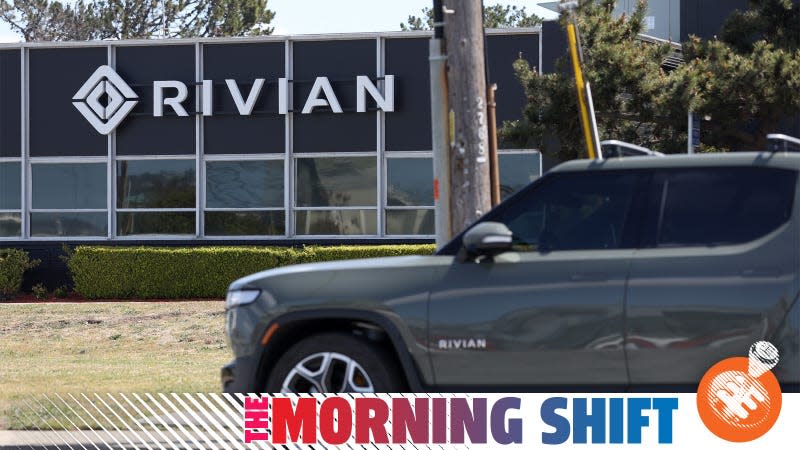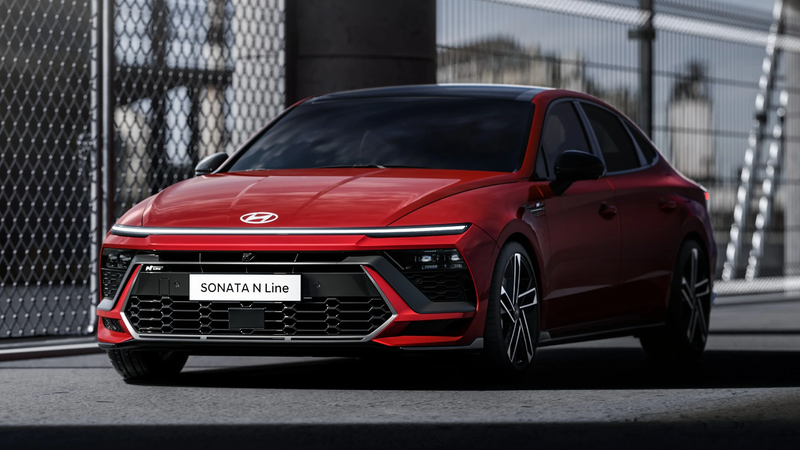Rivian Is Relocating Engineers in Hopes of Boosting Production

Rivian wants to consolidate its engineering talent under two roofs, a Tesla factory worker subject to racial harassment is taking the electric car maker to court again for a fair payout and Audi is messing with the names of its many, many car models again. All that and more in this edition of The Morning Shift for Monday, March 27, 2023.
1st Gear: Rivian Employees On the Move
Rivian’s experiencing those typical EV startup production growing pains, and it’s going to try and overcome them by moving its engineering core to its bases of operations in Normal, Illinois and Irvine, California all in the name of expediting production, according to a Wall Street Journal report from Friday:
Read more
The young company is in part trying to centralize more of its workforce. During the Covid-19 pandemic, Rivian hired engineers wherever it could find them and allowed them to work remotely, the person familiar with the plans said.
As a result its employees are scattered across the U.S. in states like Michigan, Texas and Virginia, in addition to those located at the headquarters and in Illinois, the person added.
The relocations come as Rivian is overhauling its sole production facility to expand both the speed and capacity of its assembly lines. The team being relocated to Normal, Ill. is responsible for the design and functioning of the factory, from the machines that help build the vehicles to layout of the assembly line. [...]
So far, management has had some conversations with the manufacturing-engineering team, and a few dozen employees have indicated an unwillingness to move, the person said. For those who won’t relocate, Rivian plans to offer them severance and fill vacancies created with new hires, the person said.
The company, which employs about 14,000 workers, went public in late 2021 and grew rapidly during a period where remote work was the norm.
Of course, Rivian’s manufacturing woes aren’t squarely to do with where its workers are located. Difficulty securing parts has plenty to do with it, too. The Journal has not been able to report how many employees would be relocated. But it did call out Rivian’s attempts to launch three disparate models at once: the R1T truck, R1S SUV and the oft-forgotten Amazon delivery van, which isn’t corralling the kinds of returns on investment that the company was hoping. At least not yet. Maybe it’s not just about where personnel are, but what they’re spread too thin making.
2nd Gear: Germany Won
The European Union has seemingly capitulated to Germany’s wishes to let cars running on synthetic fuels slide on by in the bloc’s 2035 internal-combustion engine phase out legislation. Reuters reportedly saw a document on Monday from the European Commission clarifying the plan, based upon a deal struck late last week:
When EU countries approve the 2035 phaseout law, the Commission will create a new EU vehicle category for cars that can only run on carbon-neutral fuels.
The Commission will then present another regulation specifying how these cars can contribute to the 2035 target, the document said.
This will take the form of a delegated act - a type of law that is difficult for EU countries and lawmakers to reject. As an extra reassurance to Germany, the Commission said if this law were to be rejected, it would “follow another legislative path” to allow e-fuel car sales.
The deal paves the way for EU countries’ ministers to finally approve the 2035 phaseout law for new combustion engine cars on Tuesday, allowing it to enter into force.
Italy, which wants cars that run on biofuels to also be exempted from the 2035 phaseout, on Monday tried unsuccessfully to delay the vote.
Have to hand it to Italy for going that little bit further to continue to erode the spirit of the law, which is to end internal combustion engines. Not replace gasoline with a greenwashed version of itself, which won’t help countries reach carbon targets any more than if we simply left the status quo as it is.
3rd Gear: Tesla’s Back in Court for Racial Harassment
Back in 2021, Owen Diaz, a Black elevator operator at Tesla’s Fremont plant, was awarded $137 million in damages after being subjected to severe, repeated racial harassment. The automaker challenged the verdict last spring and got a California district judge to cut it down to about 11 percent of that amount, $15 million. Diaz and his layers rejected that, and so a new trial to determine the final payout will begin this week. From Reuters:
The trial is scheduled to last five days. Last year, a judge slashed the $137 million verdict that the jury awarded in 2021 to plaintiff Owen Diaz, one of the largest ever in a U.S. workplace discrimination case. Diaz’s lawyers rejected the lower payout and opted for a new trial on damages.
After the 2021 trial, U.S. District Judge William Orrick agreed with a jury that Tesla was liable for race discrimination but cut the verdict to $15 million. Orrick is also presiding over this week’s trial, and has barred both sides from presenting new evidence or calling new witnesses. [...]
The jury in 2021 awarded Diaz nearly $7 million in compensatory damages for emotional distress, and $130 million in punitive damages, designed to punish unlawful conduct and deter it in the future.
Orrick last year reduced the compensatory damages to $1.5 million and the punitive damages to $13.5 million. He said that sum acknowledged the pervasive harassment Diaz faced while reflecting that he had worked at the factory for only nine months and had not alleged any physical injury or illness.
This is, of course, not the only workplace discrimination case Tesla has fielded, and it’s worth recalling that the company’s original target for reducing Diaz’s payout was even much lower than $15 million — it was $600,000.
4th Gear: Audi Is Messing With Car Names Again
German automakers love to upend vaguely understood product nomenclature to fit some sort of internal philosophy nobody else cares about. It’s why the 3 Series coupe had to become the 4 Series, and why every Mercedes SUV begins with “G” now — even if “GLB” creates a weird guttural sound when pronounced as a word, which my brain will always prefer to do with any mess of alphanumerics.
Audi has recognized the electrification era as the perfect opportunity to do its own odd/even split. Except, this time, the odd numbers will form the ICE range, because odd-numbered products always have to be conveyed as less desirable for some reason. From Automotive News Europe:
Even numbers will be used for EV-only models, while odd numbers will designate internal combustion ones, including plug-in hybrids, Duesmann told journalists last week at Audi’s annual news conference. The Heilbronner Stimme, a German newspaper, first reported the change.
“We are expanding our product portfolio with new electric-drive models and that is why we are restructuring our naming conventions,” he said.
The brand’s first full-electric vehicle was the E-tron, a large SUV that was launched in 2019; it also sells the E-tron GT, a large four-door sporty sedan.
Currently Audi’s alphanumeric model names do not make a distinction between powertrains. The range starts with the small A1, and goes up to the A8 flagship sedan, Q8 SUV and R8 sports car.
German rivals BMW and Mercedes-Benz have their own naming conventions for EVs, with Mercedes adding “EQ” to its letter series, while BMW adds an “i” to its number series.
Mercedes plans to drop the EQ designation, starting as early as 2024, according to German news reports.
At least this may eventually result in the disuse of “E-tron,” a sub-brand that never stopped sounding silly even after all these years.
5th Gear: Hertz’s CFO Has Left the Building
Hertz’s Chief Financial Officer, Kenny Cheung, is leaving the rental car company, Reuters reported Monday:
The company said its Chief Accounting Officer Alexandra Brooks will serve as interim finance chief, effective April 1.
The company, which operates the Hertz, Dollar and Thrifty vehicle rental brands, said it was starting a formal search process for a CFO.
It wasn’t long ago that Hertz reemerged from the jaws of bankruptcy; it was even more recent that the company agreed to a $168 million settlement for getting 365 law-abiding customers wrongly arrested, including one woman who it put in cuffs four times. Might just be me but $168 million seems like nowhere near the universe of being enough, especially when a number of these customers spent months behind bars.
Reverse: From Textiles to the Trueno
On this day in 1952 — 71 years ago — the world lost Kiichiro Toyoda at just 57, the founder of the Toyota Motor Company. Courtesy History.com:
Toyoda was born in Japan on June 11, 1894. His father Sakichi Toyoda was an inventor of textile machinery, including an automatic loom, and founded Toyoda Loom Works. (People called him “Japan’s Thomas Edison.”) By the late 1920s, Kiichiro Toyoda, who worked for his father’s company, had begun plans to develop an automobile. (Sakichi Toyoda died on October 30, 1930, at the age of 63.) In 1933, Kiichiro Toyoda established an auto division within Toyoda Loom Works, which released a prototype vehicle two years later. In 1937, Toyota Motor Corporation was formed as a spinoff of Toyoda Loom Works. (“Toyota” was reportedly considered a luckier name than “Toyoda” and is easier to write in Japanese characters).
The new car company initially looked to the U.S. auto industry for inspiration. According to The New York Times: “Over the years of its rise to the top, Toyota has made no secret of how much it has learned from Detroit. Its first car, the AA, was a blatant copy of (or an homage to) a Chevrolet sedan. Its executives scoured every corner of the Ford Motor Company in the 1950s, taking home ideas to Japan that later inspired the Toyota Production System.”
Kiichiro Toyoda died in 1952, but his company continued to grow. In 1966, Toyota introduced its compact Corolla model, which in 1997 became the world’s best-selling car, with more than 35 million sold at the time. The oil crisis of the 1970s made Toyota’s small, fuel-efficient vehicles increasingly attractive in America. In the 1980s, the automaker launched the popular Camry compact car and 4Runner sport utility vehicle. Toyota’s luxury car line, Lexus, debuted in the U.S. in 1989. The automaker introduced the planet’s first mass-produced hybrid vehicle, the Prius, in 1997 in Japan and worldwide in 2001. By the end of the 1990s, Toyota had produced over 100 million vehicles in Japan.
Neutral: The New Sonata Looks So Much Better Than the Old One

Hyundai’s design is either horrendous or phenomenal, and the Sonata has just gone from the former extreme to the latter . More cars deserve such a glow up.
More from Jalopnik
Sign up for Jalopnik's Newsletter. For the latest news, Facebook, Twitter and Instagram.

 Yahoo Autos
Yahoo Autos 